
Home > SaaS Pricing Models: Expert Guide to Choose the Right SaaS Price Model
Table of Contents
ToggleOver the past few years, SaaS industries have seen rapid growth and have proven to be progressive and scalable. In fact, Gartner Group the growth of SaaS technologies has been forecasted to reach $278 billion by the year 2021.
According to a McKinsey study, a 1% change in price can cause an 8.6% change in profitability.
Pricing is something that requires a lot of thought and not something you should choose by just looking at your competitors. You should approach it with methodical thinking, the same way you carefully design your product strategy, business model, and other elements of your SaaS business.
To come up with an effective pricing strategy, you need to consider your target audience, service level, market position, and customer satisfaction.
(Note: Customer is the main input when developing a price)
In this blog, we’ve enlisted 7 enterprise SaaS pricing models companies use, along with some advantages and disadvantages of each, so you can pick the best one for your business:

The pros and cons of these pricing models for SaaS will not only help you identify the optimum way to market but also sell and grow your SaaS business.
Tiered User Pricing is the most popular pricing strategy implemented by popular SaaS companies like HubSpot, Confluence, Hootsuite, etc.
In this pricing strategy, you can charge based on the number of users who may use that service. For instance, a SaaS company might charge a particular price for, say, up to 5 users, and as the number of users increases the price goes up.
Pros:
Cons:
Pricing Model Example:
Hootsuite: Offers different pricing options based on the number of social profiles and users, each pricing can be customized for specific buyer personas, considering that not all users will need the same set or amount of features.
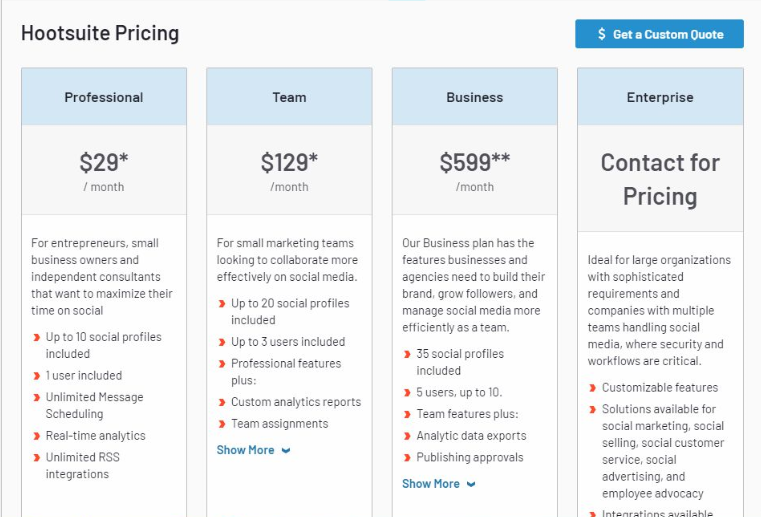
For cloud storage companies, the most suitable pricing model has to be this one as it is based on the storage people might need.
For example, cloud storage companies like Dropbox give their customers a certain amount of free storage, and for additional storage – “Cha-Ching”.
Pros:
Cons:
Product Pricing Model Example:
Dropbox: Offers 2 sets of pricing models – for businesses and individuals.
Dropbox business pricing – is based on the amount of storage the user requires, starting with 3 users, and can be billed monthly or yearly.
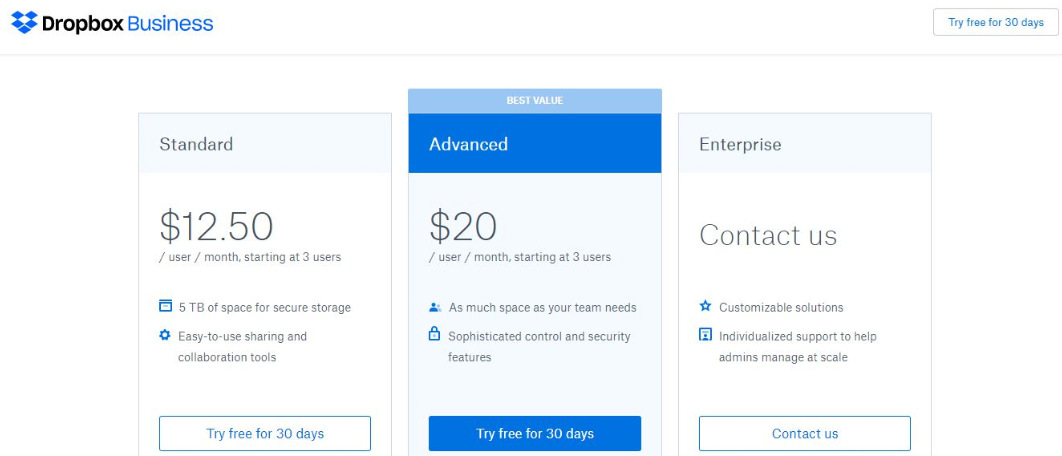
Dropbox individual pricing – is based on the amount of storage a user requires, and in the case of Family it also increases the number of users; this can also be billed monthly or yearly.
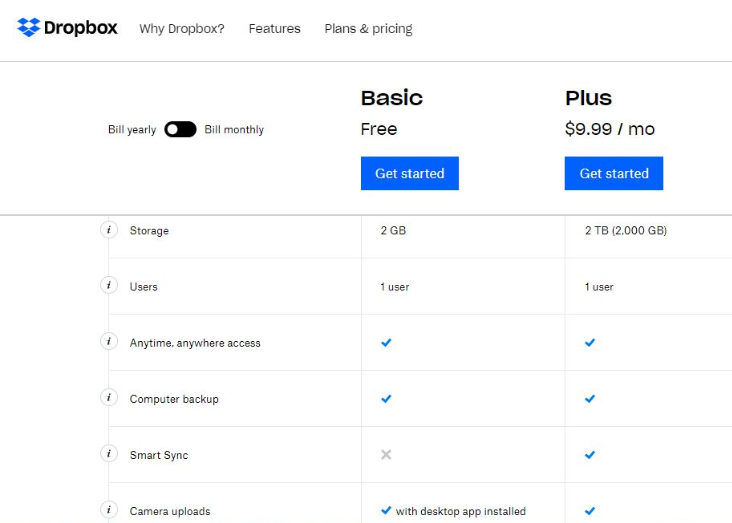
As is evident by the name, this SaaS pricing model differentiates prices based on services and upgrades available to customers, i.e., to unlock more features customers need to loosen their wallet strings.
Pros:
Cons:
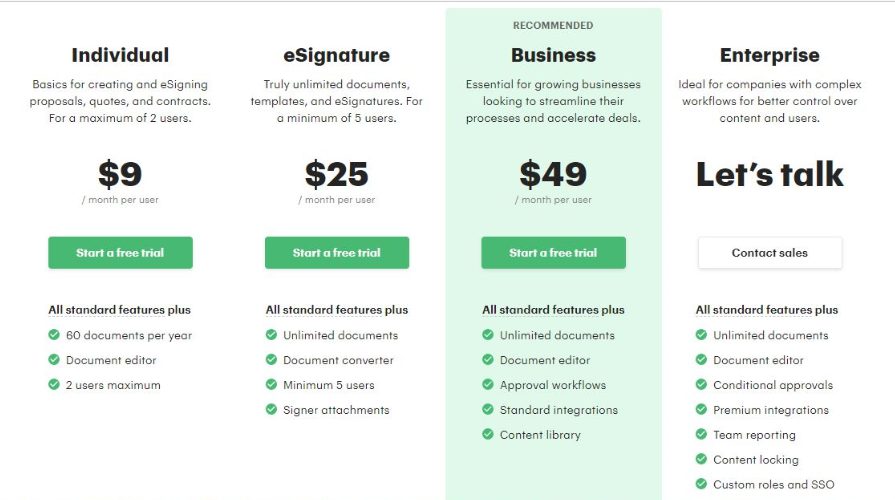
Pricing Model Example:
PandaDoc: Pricing is primarily focused on the set of features they offer their users and as the number of features or add-ons increases, so does the price.
This pay-as-you-go SaaS pricing model charges customers based on their usage, the more they use a service the more they’ve to pay, simple!
Companies like PandaDoc, Dropbox, Intercom, etc. allow customers to pick the add-ons they want.
Pros:
Cons
Pricing Model Example:
Amazon Web Services: AWS has a pay-as-you-go pricing model for over 160 cloud services, i.e., you pay only for the services you need, no matter the duration you’re using them for, more like the way you pay for electricity.

You can also provide some awesome functionalities of your software for free and have a range of upgrades.
Like on LinkedIn.
Users get a lot out of LinkedIn with the free version, but they have numerous upgrade packages like LinkedIn Premium Account to help job seekers, recruiters, and business owners.
According to Manan Shah, CEO of recruiterflow, “The user acquisition of the freemium model is about 50% for SaaS company’s cash flow.”
The only drawback of the Freemium model is that there’s always a chance that most people won’t need or wouldn’t want to sign up for a paid version. This model is being actively used by some top companies like Slack, Evernote, and Dropbox.
Pros:
Cons:
SaaS Pricing Model Example:
Slack: With a basic freemium model with limited features, slack allows its users to experience the product and hopefully upgrade to leverage some key features.
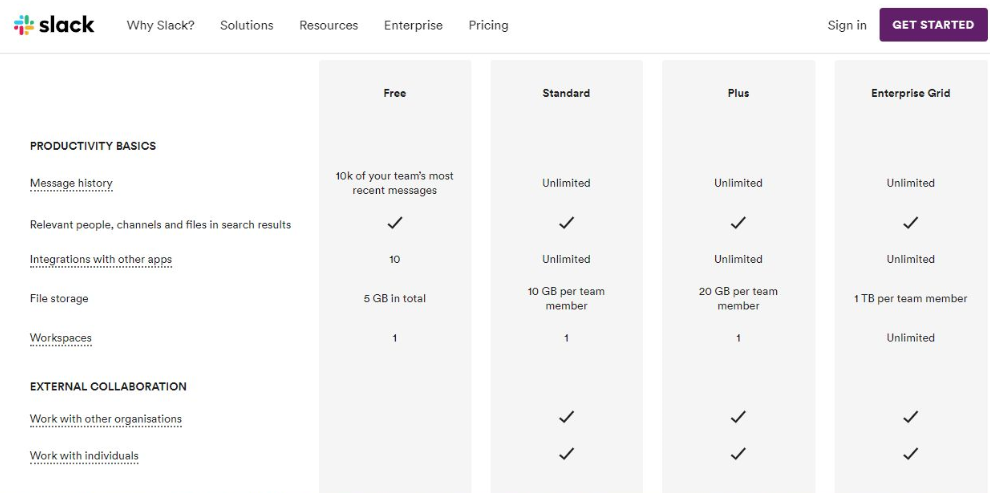
When you move beyond the freemium model, some companies charge a flat or a subscription rate for all their upgraded services, with no further difference. In simple words, it’s a single service, at a single price with a single set of features.
It’s a very simple and easy option for customers as it makes it easy for SaaS companies to be sure of the revenue they’ll be getting.
Pros:
Cons:
Pricing Model Example:
Evernote: Offers a single subscription price with a single set of features, this makes it easy to select as users don’t need to think a lot about their subscriptions and the individual set of features they want.

It’s the most common SaaS pricing model, where users are charged depending on the number of people who use that service. But according to Patrick Campbell of Price Intelligently, “SaaS companies might hurt their business with this pricing model, especially a company with multiple users.”
The disadvantage of this model is that you need to cut down on the number of people who can get to know and use your software.
It also limits the potential number of active users, which is not at all good for your SaaS company.
Pros:
Cons:
Pricing Model Example:
Calendly: Depending on the number of users who are using its services, calendly offers 3 sets of pricing options to its users; billed monthly and yearly.
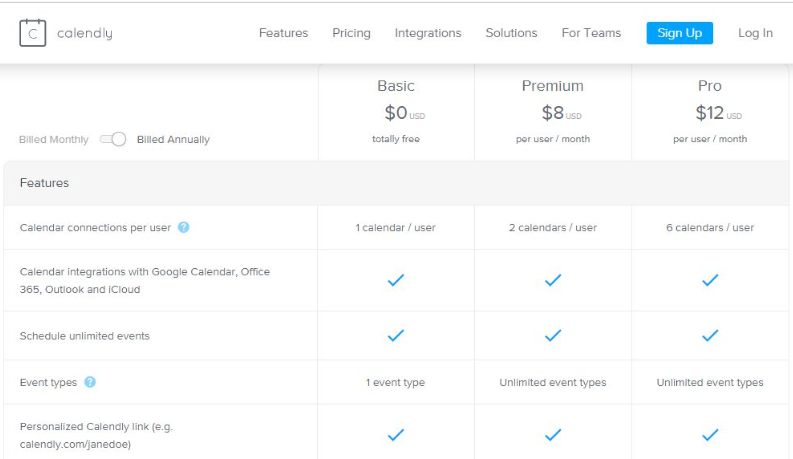
Finding the right SaaS pricing model is like playing Jenga, a single wrong move can collapse the entire thing. You need the perfect balance between what your customers are willing to pay with what will make your business profitable. Your product pricing model is not a “mere landing page” on your website, it’s the center of your business because, to state a fact you might have put in all your efforts to acquire customers, but in the end, it’s your pricing model that will decide whether or not they will actually sign up for your product.
According to a survey conducted by OpenView, “more than 40% of the SaaS companies never test their pricing strategy, and about 55% haven’t conducted a research to understand what amount their target customers are willing to pay.” This is definitely not the right approach for any SaaS business, so here’s a list of the essential things you need to consider and some critical questions you need to ask while evaluating and choosing a SaaS pricing strategy. Here are some key points to consider that can help you choose the right SaaS pricing model:
Let’s dig in!
You need to define your target market and conjure a buyer persona to understand the pain points of your potential customers. To use personas more effectively you can also conduct surveys and polls. You will get a clear understanding of what problems you are solving for them which will help you understand the value of your product, and your USPs and decide on the right price.
Once you understand what problems are you providing a solution to for your customers, you’ll be able to better communicate the value your product plays in solving that issue.
You also need to analyze the industry you are in and this will help you narrow down your competitors, the loopholes (if any), and the strengths and weaknesses of your product, referred to as a SWOT (Strengths, Weaknesses, Opportunities, and Threats) analysis so you can leverage your USPs and design a killer Marketing Strategy.
For instance, if you don’t have any competitors in the market – your product is unique, you can easily get customers to pay for it as in this case they won’t have any options with offering a free trial.
Having a completely unique product is indeed an ideal situation, but that’s not the case most of the time. Having competitors can actually be beneficial as they have already gone a long way and have tried and tested a lot of strategies and concepts, you can analyze their strategies and see what worked for them to implement as a part of your business strategy.
Check for your Primary Competitors – they are your direct competitors as they are either targeting the same audience or have a similar product — or maybe both.
Research every aspect of your competitors – their traffic sources, backlink profile, onboarding process, email campaigns and social network strategies, and most importantly their revenue models and pricing strategies in the b2b saas market.
The first thing you need to understand is how much you need to charge your customers to maintain a perfect balance between customer satisfaction and your profitability. To deduce that you need to calculate:
A CLV greater than 3 to 5 times your CAC is what you should be looking for as this ratio helps you determine the efficiency of your pricing model.
Note: Your CLV is the variable quantity and is based on the pricing you end up choosing.
First impressions are always important, this makes it vital to delivering an amazing initial experience to your customers. A great onboarding experience is imperative especially if you are offering a free trial. You can also offer a complete walkthrough or a video call to help them through the onboarding process.
To decide on what should be the ultimate price of your product you need to analyze both sides of the coin, what will keep your business running, and what your customers will be happy to pay for your services. To understand this, you need to ask your customers the following questions:
The fact is that it might make sense to charge some customers more or less than others based on their needs and what they’re using it for.
When you charge customers more or less than others based on their needs and the pain points they are using, this software is called “differential pricing.” E.g., student discounts offered by many stores.
One way of making SaaS businesses grow exceptionally is through upselling (the growth of your acquired customers), known as “Expansion MRR”. It costs very little as compared to acquiring new customers and can increase MRR by strategically creating pricing tiers.
The most common model used to leverage the benefits of upselling is the “feature-based” or “value-based” pricing. You need to research your customers – analyze each stage of growth and understand at which point in their buyer journey they will most likely need an upgrade. Once you understand your customers you can tailor your services accordingly thus leading to growth at every stage of the buyer funnel.
Although selecting a SaaS pricing model will depend on several things, the value-based approach is seen to be one of the best and most effective SaaS price models. As we have seen with some companies, a better approach to deciding which strategy you should implement is – to mix and match pricing depending on your audience.
It’s you who will decide which of the aforementioned SaaS billing models will work the best for your company and which ones you can combine to get the most benefit out.
Remember that pricing isn’t a decision to be made by a single department. You need to take suggestions from your Marketing, Sales, and Product Department as they help you a position, target, and manage your audience effectively.
Ameet Mehta‘s expertise lies in building revenue engines for technology-enabled companies and private equity investments. He began his journey with TechStars Chicago and has since founded and acquired several companies through FirstPrinciples Holding Company. The FirstPrinciples portfolio generates over $7M in revenue/year with most companies in the SaaS space. He...